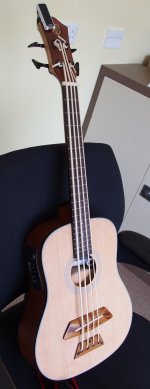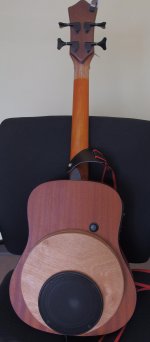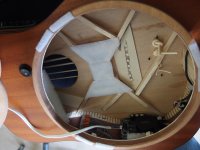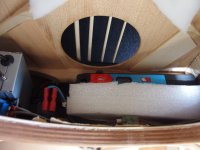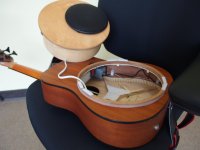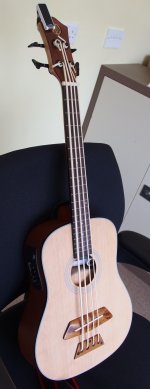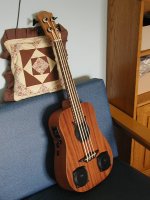OK, to clarify:
I did originally link to a 24V power bank. I knew the TPA3116 would do better with 24V, so I searched until I found one at a reasonable price, and I bought it. But the problem with these powerbanks that do 24V is that they all have an output with selectable voltage, 5 or so to 24V. This means that there is a DC to DC converter involved. So, I'm not sure if the thing I got was faulty, or the converter couldn't handle the draw from the amp, or the converter just coloured the supply too much, but the thing didn't work. It made my driver do strange large cone excursions, and distortion, etc. so I returned it and bought the 12V one because it's the same one my friend who built one of these got, and because I can't find a 24V battery with no DC to DC converter. Now, he used a stereo amp with two chips, and two Dayton Audio ND90 drivers. I know those are tiny, like 3", but that's what he did, and I imagine, he'll get more sound out of that at 12V then I will with one chip.
So here's what I'll do: I'll get a couple of big 7Ah lead acid batteries, wire them in parallel, and try it with that. If the amp makes no distortion, I'll know the one 12V battery is not big enough, and I'll either get two, or find a 24V battery.
See how it goes...
I did originally link to a 24V power bank. I knew the TPA3116 would do better with 24V, so I searched until I found one at a reasonable price, and I bought it. But the problem with these powerbanks that do 24V is that they all have an output with selectable voltage, 5 or so to 24V. This means that there is a DC to DC converter involved. So, I'm not sure if the thing I got was faulty, or the converter couldn't handle the draw from the amp, or the converter just coloured the supply too much, but the thing didn't work. It made my driver do strange large cone excursions, and distortion, etc. so I returned it and bought the 12V one because it's the same one my friend who built one of these got, and because I can't find a 24V battery with no DC to DC converter. Now, he used a stereo amp with two chips, and two Dayton Audio ND90 drivers. I know those are tiny, like 3", but that's what he did, and I imagine, he'll get more sound out of that at 12V then I will with one chip.
So here's what I'll do: I'll get a couple of big 7Ah lead acid batteries, wire them in parallel, and try it with that. If the amp makes no distortion, I'll know the one 12V battery is not big enough, and I'll either get two, or find a 24V battery.
See how it goes...
Yes, and probably tiny lithium cells, to make room for both battery and DC-DC converter in that rather small housing.This means that there is a DC to DC converter involved.
A single lithium-ion or lithium-polymer cell reaches 4.2V hot off the charger, and around 4 V at full charge once it's settled down, dropping to about 3.7 volts when discharged. So you really need six of these in series to make an honest 24 volts. DeWalt has a line of tools using a 5-cell pack, and somewhat optimistically branded "20V Max".
Three decibels more, all else being the same...(which it might not be, since you're using different speakers, etc.)I imagine, he'll get more sound out of that at 12V then I will with one chip.
You mean series, right?couple of big 7Ah lead acid batteries, wire them in parallel,
-Gnobuddy
Just a quick mess tonight with my psu and class d amp. Reducing voltage makes it work or not work
Keeping the voltage constant and reducing the amperage results in horrible distortion. I tried a 5v to 12v DC DC converter once and as the voltage rose the amps fell and everything got really hot. I'd say this is the issue.
Keeping the voltage constant and reducing the amperage results in horrible distortion. I tried a 5v to 12v DC DC converter once and as the voltage rose the amps fell and everything got really hot. I'd say this is the issue.
OK, I tried my amp with 24V+ from two 12V 7Ah SLA batteries in series. It's awful! As soon as I turn it on there is a fairly loud, continuous high pitched whine from the speaker. When I play the uke, the distortion is really bad.
Now, as I see it, with these batteries I have totally clean DC, and no current limit, at least nowhere close to what the amp draws. Also, I have no DC to DC converter, so no problems that those cause. So I think the amp board is simply bad. If I'm missing something, please point it out...
Actually, with my 12V car starter battery, I have essentially the same conditions as above, except with the lower voltage it should just start to distort a bit sooner. But, here's the thing: What I'm getting is not gradually increasing THD. It's more that it suddenly starts at a certain volume level, and then just as suddenly cuts out as the volume drops below that level. So at a medium level, when I pluck a string there is obviously a volume peak, and it distorts, but then as the sound decays the distortion suddenly stops and the sound is clean. Then of course as I turn the level up the distortion stays longer before cutting out. Hopefully this make sense, as I have no easy way of recording what I mean.
Anyway, the distortion doesn't sound like just the normal THD, but more like the amp has a problem, to my untrained ear anyway. And, the whine that is present at 24V also points to this IMO
Gnobuddy/Jim, what do you think?
Now, as I see it, with these batteries I have totally clean DC, and no current limit, at least nowhere close to what the amp draws. Also, I have no DC to DC converter, so no problems that those cause. So I think the amp board is simply bad. If I'm missing something, please point it out...
Actually, with my 12V car starter battery, I have essentially the same conditions as above, except with the lower voltage it should just start to distort a bit sooner. But, here's the thing: What I'm getting is not gradually increasing THD. It's more that it suddenly starts at a certain volume level, and then just as suddenly cuts out as the volume drops below that level. So at a medium level, when I pluck a string there is obviously a volume peak, and it distorts, but then as the sound decays the distortion suddenly stops and the sound is clean. Then of course as I turn the level up the distortion stays longer before cutting out. Hopefully this make sense, as I have no easy way of recording what I mean.
Anyway, the distortion doesn't sound like just the normal THD, but more like the amp has a problem, to my untrained ear anyway. And, the whine that is present at 24V also points to this IMO
Gnobuddy/Jim, what do you think?
You may be right. It's hard to be sure from this distance, and I try not to just say "Go buy another one" - it's too easy to say when someone else's money is at stake! I'd rather be as sure as possible that you really do have a bad amp board.So I think the amp board is simply bad.
So, just to be sure:
1) Lots of hum and buzz could mean there is no grounding, or a grounding mistake. Batteries aren't grounded, and you have an instrument with plastic (non-conductive) strings, so the entire amp may be operating with no ground at all, not even through your fingers (grounding through your fingers is very dangerous for devices operated off the AC mains, but safe enough for low-voltage battery operated devices.)
So, double check the grounding. If there isn't any sort of ground, temporarily run a wire from amp ground (- power supply rail) to something like a metal cold water pipe in your house. Does that make the buzz go away?
2) Try the suspect amp with a different audio source (not the 'uke). Play some MP3s through it, something like that. Does it still distort and misbehave?
If the board distorts and misbehaves with any input source, while your other (NAD?) amp behaves well with the same input sources, then there are certainly a lot of fingers pointing at the class D board as the source of the trouble.
This certainly isn't normal behaviour. It could be caused by something like instability in the power amp board. Is the 'uke pickup physically located close to the loudspeaker wires? This could allow stray capacitance between the two to cause high-frequency feedback, and therefore, instability....not gradually increasing THD...suddenly starts at a certain volume level, and then just as suddenly cuts out as the volume drops below that level.
Testing the class D board with a different signal source (MP3 player, etc) might help diagnose this, too. If the amp behaves well with the MP3s, the finger points to the 'uke pickup as the source of the trouble. If the amp misbehaves with every source, it's the amp that's suspect.
-Gnobuddy
Test the suspect amp with a completely floating source, one not otherwise connected to ground or the battery pack. I use an iPAD or smartphone. An MP3 player would do. There must also be no connection from the speaker wiring to ground or the battery pack. Many class D amps will go crazy if there is a ground loop, or even when connected to another source which is on the same power supply.
I have some little 12 volt power Dayton (parts express) class D amps that work fine from a floating source, but whine and generally misbehave when fed from a PC and powered from the 12 volt power supply in the PC. All 3 of them do exactly the same thing, and all work from the PC when fed by a different power supply, and work fine when fed by the computer's power supply and the source is an iPAD.
A different class D amp works fine in the PC setup but is too big for my project.
I have some little 12 volt power Dayton (parts express) class D amps that work fine from a floating source, but whine and generally misbehave when fed from a PC and powered from the 12 volt power supply in the PC. All 3 of them do exactly the same thing, and all work from the PC when fed by a different power supply, and work fine when fed by the computer's power supply and the source is an iPAD.
A different class D amp works fine in the PC setup but is too big for my project.
Sorry, I have been testing this, but it's been a busy work week, and other stuff gets in the way of having fun!
So I did try the amp with other sound sources, though I didn't get to trying better grounding, and it's clear to me that the problems follow the amp, rather than anything else, and are pretty consistent no matter what I power it with.
I also managed to look at this project with my friend who has already built one of these, and his point about the amp was that the threshold at which it suddenly starts to distort may well be above the threshold at which I would get feedback once the speaker is mounted into the uke. He said that he also gets a similar noise when he drives his uke too hard. He recommended that I continue with the build (the next issue to work out is to design as big an enclosure as I can that still fits in the uke body) and then try with this amp. I may well be that it works fine, and feeds back long before it distorts. The fact is that is does make a nice sound with the ND140 driver at reduced levels, and does also make every bit as much noise as a upright bass before distorting.
So I think I will keep the amp as is for now, and move ahead with the rest of the build, knowing I can change the amp later if I need to.
My friend went home after seeing my project, and decided to try upping the voltage on his uke from 12 to 21.6 provided by a spare Dyson hand vac battery. He reported that his volume before clipping went up considerably, though he had to partially dismantle the battery to get past circuitry that senses current before switching on, since the amp didn't seem to draw enough to trigger it. I would also like to use 24V, but I am really having trouble finding a 24V lithium battery that does not have a dc to dc converter involved, but still has a charge controller. I'm told that you must have accurate charge control on these multicell lithium packs, because small imbalances between the cells can ruin them. So it seems that something like this: 2019 LiitoKala 24V 6Ah 7S3P 18650 Lithium Ion Battery 29.4V 6000mAh For Electric Bicycle From Liitokala2019, $37.19 | DHgate.Com wouldn't have that, and therefore wouldn't last long. Anyone know anything about this? Or know of a good laptop power bank or car jump starter that puts out a clean 19-24V?
So I did try the amp with other sound sources, though I didn't get to trying better grounding, and it's clear to me that the problems follow the amp, rather than anything else, and are pretty consistent no matter what I power it with.
I also managed to look at this project with my friend who has already built one of these, and his point about the amp was that the threshold at which it suddenly starts to distort may well be above the threshold at which I would get feedback once the speaker is mounted into the uke. He said that he also gets a similar noise when he drives his uke too hard. He recommended that I continue with the build (the next issue to work out is to design as big an enclosure as I can that still fits in the uke body) and then try with this amp. I may well be that it works fine, and feeds back long before it distorts. The fact is that is does make a nice sound with the ND140 driver at reduced levels, and does also make every bit as much noise as a upright bass before distorting.
So I think I will keep the amp as is for now, and move ahead with the rest of the build, knowing I can change the amp later if I need to.
My friend went home after seeing my project, and decided to try upping the voltage on his uke from 12 to 21.6 provided by a spare Dyson hand vac battery. He reported that his volume before clipping went up considerably, though he had to partially dismantle the battery to get past circuitry that senses current before switching on, since the amp didn't seem to draw enough to trigger it. I would also like to use 24V, but I am really having trouble finding a 24V lithium battery that does not have a dc to dc converter involved, but still has a charge controller. I'm told that you must have accurate charge control on these multicell lithium packs, because small imbalances between the cells can ruin them. So it seems that something like this: 2019 LiitoKala 24V 6Ah 7S3P 18650 Lithium Ion Battery 29.4V 6000mAh For Electric Bicycle From Liitokala2019, $37.19 | DHgate.Com wouldn't have that, and therefore wouldn't last long. Anyone know anything about this? Or know of a good laptop power bank or car jump starter that puts out a clean 19-24V?
Why not let the uke body itself be the enclosure?...design as big an enclosure as I can that still fits in the uke body...
That is true, but damage to the battery is not the worst of it - there are much scarier factors to consider.I'm told that you must have accurate charge control on these multicell lithium packs, because small imbalances between the cells can ruin them.
Lithium batteries have a long history of bursting into extremely high-temperature flames if anything goes wrong with them. One of the things that can go wrong is charging any one cell beyond 4.25 volts, at which point metallic lithium plates out of the electrolyte onto the electrodes, followed by white-hot flames and very unpleasant thick black smoke.
Now, when you put multiple cells in series, they will never all have exactly identical capacity, which inevitably means one of them will reach full charge sooner than the others. If the charger continues to charge the pack (which will not yet show as fully charged), that cell is likely to turn into an incendiary device.
This is no scare-mongering: I personally knew three men whose vehicles were completely destroyed by lithium battery fires between 2004 and 2006. At the time, one of my hobbies was flying lithium-powered radio controlled model aircraft, and all three of these men had the same hobby. Each of them ignored at least one of the safety rules around lithium batteries, and each of them paid for that carelessness.
One of the things that's changed since then is that every reputable manufacturer includes charge balancing circuitry in either the charger, or the battery pack itself. The balancing circuitry monitors each cell in the pack, and as soon as any cell charges fully, routes the charge current around it, so that the rest of the pack can continue to charge, without overcharging the fully charged cells in the pack.
Overcharging is not the only thing that can trigger lithium batteries to burst into high-temperature flames. It can happen if the internal chemicals are not pure enough. It can happen if the pack suffers physical damage, such as being dropped. It can happen if the pack is stored at too high a temperature, such as inside a car parked in bright sun.
There are more dangerous types of lithium cells (lipo, or lithium polymer, housed in a flexible plastic pouch), and less dangerous types (li-ion, or lithium ion, which have a metal housing.) But all of them can and have caused fires that have destroyed cars, garages, and sometimes, houses.
Even the big guys - reputable companies with good quality control - have had problems with lithium fires:
1) Apple laptops burst into flames: 15-inch MacBook Pro Battery Recall Program - Apple Support
2) Boeing Dreamliner fires: Boeing 787 Dreamliner battery problems - Wikipedia
3) Two million Samsung Note 7's recalled due to fire risk: Samsung permanently stops Galaxy Note 7 production - BBC News
4) Half a million hoverboards recalled: Half A Million 'Hoverboards' Recalled Over Risk Of Fire, Explosions : The Two-Way : NPR
5) Amazon battery fires: Lithium-Ion Batteries From Amazon Are Exploding - The Atlantic
6)"Why Lithium Batteries Keep Catching Fire", The Economist: https://www.economist.com/the-economist-explains/2014/01/27/why-lithium-batteries-keep-catching-fire
7) Recyclers struggle with lithium fires from old electronics: https://www.washingtonpost.com/tech...ones-other-gadgets-they-literally-catch-fire/
Having seen (and smelt) three vehicles that burned to destruction due to lithium battery fires, I take the fire risk from these batteries very seriously. During the years when I used them in my radio control models, my batteries lived in a fire-proof safe out in the back yard, on a concrete pad, with an inverted metal mesh waste-basket over it to catch flaming debris should the worst happen (secondary fires are the big danger with lithium pack fires.) I always used a balancing charger, never charged packs in my house or my car, and always made sure there was nothing combustible for at least 15 feet (5 metres) in every direction, including upwards, during charging. Charging and storage was done with a Ziploc bag full of sand placed over the pack, in the hope that the sand would capture flaming debris and smother the fire .
This was still no guarantee of safety (I had to transport packs in the back of my car when I went flying). There is no foolproof solution to lithium battery safety. I feel that the general public has not been adequately informed just how dangerous these batteries can be. For example, this Wikipedia page might get your interest: https://en.wikipedia.org/wiki/Plug-in_electric_vehicle_fire_incidents
It's quite true that you can now buy cordless power tools with lithium ion batteries. Presumably if one of these catches fire and destroys your house, garage, or car, your home insurance will cover the damage.
But what happens if you have a home-brew electronic device with a lithium pack, and it catches fire? Will your insurance cover the loss of property that results? I cannot say for sure, but insurers are in the business of avoiding paying out claims by any means they can. If they can find an excuse not to pay, they won't pay. I very much doubt they would pay for a fire caused by a DIY enthusiast who built his/her own lithium powered electronics gadet.
On top of this, our legal system is insane. If I were to offer advice on lithium packs, and you followed it, and burnt down your house as a result, the legal system could find me liable for your damages.
Because of all this, all I can say is, please be aware that there is a significant hazard attached to the use of any and all lithium battery powered devices. Beyond that, I cannot offer any advice. I disclaim any responsibility for any damages to people or property that result from your own actions regarding the use of a lithium battery pack.
-Gnobuddy
I may have been overoptimistic about manufacturers and insurers accepting liability for their flawed devices. Here's the tragic tale of one family whose house was burned to the ground as the result of an Apple iPhone catching fire while being charged: https://www.cbc.ca/news/canada/brit...tery-blamed-langley-bc-laurica-farm-1.4549111Presumably if one of these (commercially manufactured lithium-battery devices) catches fire and destroys your house, garage, or car, your home insurance will cover the damage.
From that article:
All three of the vehicles I saw destroyed by lipo packs suffered the same fate - in all three cases, the vehicle owner ignored the safety rule never to charge a pack in a vehicle. In each case, the battery burst into high temperature flames while being charged inside the vehicle, igniting upholstery, seat foam, and plastics (door panels, dashboard, wire insulation) in the car interior."Fire officials who found the blackened device while investigating reported that "it would appear that the phone or charger generated enough heat to ignite" in a chair that was identified as the place the fire started."
-Gnobuddy
Ok, go and build it.
Then YOU tell us the results.
So I went ahead and built it.
Attached are a few pics of the finished article. I ended up having to change a few of the components. The amp did turn out to be bad, or at least when I replaced the cheapo Ebay one I originally got with this from Sure: WONDOM | STORE which is very nice, and solved all the problems I had been having with the first amp running at 24V. Same TPA3116 chip, but just a more quality build, I guess. Then I upgraded the battery. I figured out that the market that has exactly the batteries I need is the cordless vac market, and this battery is perfect: Spare Replacement 22V Lithium Battery For BCS01 Cordless Stick Vacuum | Vytronix with built in charge and cell management, and a clean (no DC-DC converter) 22V output. I got this linear buck converter: DC Linear Converter Buck Step Down LM317 Low Ripple Module Power Supply CF UK 664091564164 | eBay since I have been told that a linear buck converter makes the cleanest supply, and it seems to work great, converting the 22V to 9V to power the pickup. The Dayton driver in a 2.78L (biggest I could fit in the tiny uke) works fine, even though theoretically the enclosure is way too small. I may one day get a bass guitar EQ to shape the tone better, and boost up the bottom string a bit, but it works pretty good without, and I can get serious volume before it starts feeding back. Actually, at top volume it still works OK, though it can start feeding back if I don't keep the strings damped. Reduce the volume off the top slightly, and I get no feedback at all, but still get a seriously loud sound, enough to rattle pots in the dish drainer on the other side of my living room!
Overall, I am very happy. The uke has already had it's debut jamming with some friends, to favourable reviews. It really does sound like a upright bass in a much smaller and more manageable package.
Anyone else want to have a go?
Attachments
Last edited:
Congratulations!Overall, I am very happy.

No comfort issues from the loudspeaker firing directly into your tummy / chest while you play?
-Gnobuddy
Congratulations!
No comfort issues from the loudspeaker firing directly into your tummy / chest while you play?
-Gnobuddy
Thanks!
Actually, I carefully positioned the speaker so it fires just past my side, at least with playing position I use, and it seems not to make a difference to sound levels to have it firing out the back.
That was the surprise to me, the speaker on the back and enclosed. Both which should help with feedback. Would love to hear it.
I might get around to posting a recording, though I'm not sure I want to embarrass myself - I'm no bass expert like this
You can see why I put the speaker on the back if you compare my uke aesthetically with my friend's uke that I got the inspiration from, see pictures attached. I wanted mine to not be obviously electric...and I knew that the sound would be heard from the front no problem, since the low frequencies are not really directional at all.
Attachments
That is impressive. But - there is a reason why the wild and crazy overpowering bass lines of the 1980s went extinct, and are no longer heard in popular music. They overpowered the music, rather than complimenting it.I'm no bass expert like this
I love bass lines like the ones Klaus Voormann played for John Lennon on his "Imagine" album. Simple-sounding, but beautiful lines that are both melodic and harmonically correct, and which supported Lennon's weird nasal voice and limited singing ability, making him sound much better as a singer than he actually was.
Even a little Country root/fifth bass thumping would give us a taste of your Uke's sound...if you're willing, I would love to hear it, too.
-Gnobuddy
I'm struggling to decide if that's a hoax, or a work of inspired genius.For those that lean toward a fretless...
A piezo, tin can, and no EQ? Used acoustic (guitar?) strings? And it sounds so much like an upright bass instead of a steel can? Hard to believe!
-Gnobuddy
- Home
- Live Sound
- Instruments and Amps
- Self contained electric acoustic u-bass
